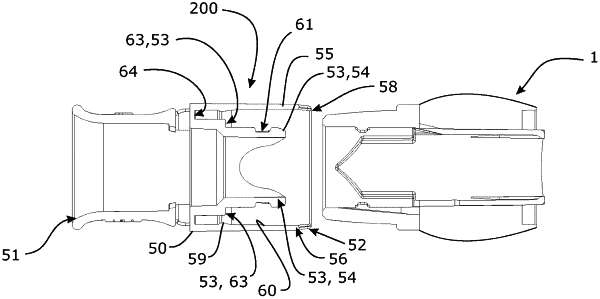| CPC A61M 16/0816 (2013.01) [A61M 16/0825 (2014.02); A61M 16/0875 (2013.01); A61M 16/1095 (2014.02); A61M 16/161 (2014.02); A61M 2205/3368 (2013.01); A61M 2205/584 (2013.01); F16L 37/248 (2013.01)] | 21 Claims |

|
1. A connector to be provided at a terminal end of a breathing conduit, the connector comprising:
a body comprising: a first end, a second end, and a lumen defined within the body between the first end and the second end, the lumen configured to pass gas therethrough;
the first end being engageable with a terminal end of a breathing conduit or at least a component to be associated with the terminal end of the breathing conduit;
the second end being engageable with a second connector; an internal portion including two or more locking fingers extending axially in the body towards the second end, the two or more locking fingers configured to connect with a female part of the second connector that is capable of receiving the two or more locking fingers;
an outer wall extending around and spaced radially outwardly a distance from the two or more locking fingers, the outer wall extending axially beyond tips of the two or more locking fingers towards the second end of the body;
wherein a diameter of the outer wall at the second end is smallest at a terminal end of the second end, with the diameter increasing in a direction extending away from the terminal end of the second end towards the first end; and
wherein the two or more locking fingers each comprising an outer surface and an opposing inner surface, the outer surface of each of the two or more locking fingers comprising a recess engageable with a complementary portion of the second connector to form a snap connection via a linear axial engagement.
|